
Xenon: what it is and how it works
Content
- Xenon and halogen: what is the difference
- What is the difference between xenon and bi-xenon?
- What kind of xenon bulbs are there?
- The device of xenon headlights
- How xenon headlights work
- Advantages of xenon lamps
- Disadvantages of xenon lamps
- How to choose xenon?
- How to install xenon?
- Related videos
- Questions and answers:
Some car owners do not pay much attention to the quality of headlights until they notice that at night and in bad weather, they have extremely poor vision of the road and what is ahead. Xenon headlights provide better and brighter illumination than conventional halogen headlights. In this article, we will look at what xenon (xenon headlights) is, how they work, and the pros and cons of installing them.
Xenon and halogen: what is the difference
Unlike traditional halogen incandescent bulbs that use halogen gas, xenon headlights use xenon gas. It is a gaseous element that can emit bright white light when an electric current is passed through it. Xenon lamps are also called High Intensity Discharge Lamps or HIDs.
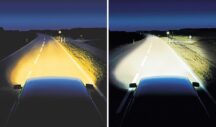
In 1991, the BMW 7 Series sedans were the first vehicles to use a xenon headlight system. Since then, major car manufacturers have been installing these lighting systems in their models. In general, the installation of xenon headlights indicates a high class and increased cost of the car.
What is the difference between xenon and bi-xenon?
Xenon is considered the best gas to fill the lamp used for the headlight of a car. It heats the tungsten filament almost to the melting point, and the quality of light in these lamps is as close as possible to daylight.
But so that the lamp does not burn out due to high temperature, the manufacturer does not use an incandescent filament in it. Instead, bulbs of this type have two electrodes, between which an electric arc is formed during the operation of the lamp. Compared to traditional halogen lamps, the xenon counterpart requires less energy to operate (11 percent vs. 40%). Due to this, xenon is less expensive in terms of electricity: it glows at 3200 lumens (against 1500 in halogens) at a consumption of 35-40 W (against 55-60 watts in standard halogen lamps).
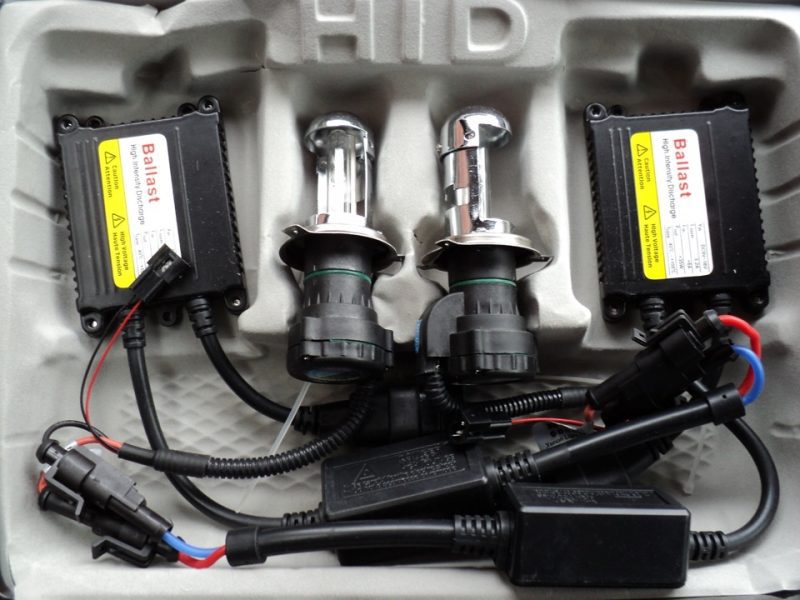
For a better glow, xenon lamps, of course, have a more complex structure compared to halogens. For example, 12 volts is not enough for ignition and subsequent combustion of gas. To turn on the lamp, a large charge is required, which is provided by the ignition module or a transformer that converts 12 volts into a temporary high-voltage pulse (about 25 thousand and a frequency of 400 hertz).
Therefore, when the xenon light is turned on, a brighter flash is produced. After the lamp starts, the ignition module reduces the conversion of 12 volts to DC voltage in the region of 85 V.
Initially, xenon lamps were used only for the low beam, and the high beam mode was provided by a halogen lamp. Over time, automotive lighting manufacturers have been able to combine two glow modes into one headlight unit. In fact, xenon is only dipped beam, and bi-xenon is two glow modes.
There are two ways to provide a xenon lamp with two glow modes:
- By installing a special curtain, which in the low beam mode cuts off part of the light beam so that only part of the road near the car is illuminated. When the driver turns on the high beam, this shade is completely retracted completely. In fact, this is a lamp that always works in one glow mode - far, but it will be equipped with an additional mechanism that moves the curtain to the desired position.
- The redistribution of the luminous flux occurs due to the displacement of the lamp itself relative to the reflector. In this case, the light bulb also glows in the same mode, just due to the displacement of the light source, the light beam is distorted.
Since both versions of bi-xenon require precise observance of the curtain geometry or the shape of the reflector, the car owner faces a difficult task in correctly selecting xenon light instead of the standard halogen one. If the wrong option is selected (this happens more often), even in low beam mode, drivers of oncoming vehicles will be blinded.
What kind of xenon bulbs are there?
Xenon lamps can be used in headlights for any purpose: for low beam, high beam and foglights. Dipped beam lamps are marked D. Their brightness is 4300-6000 K.
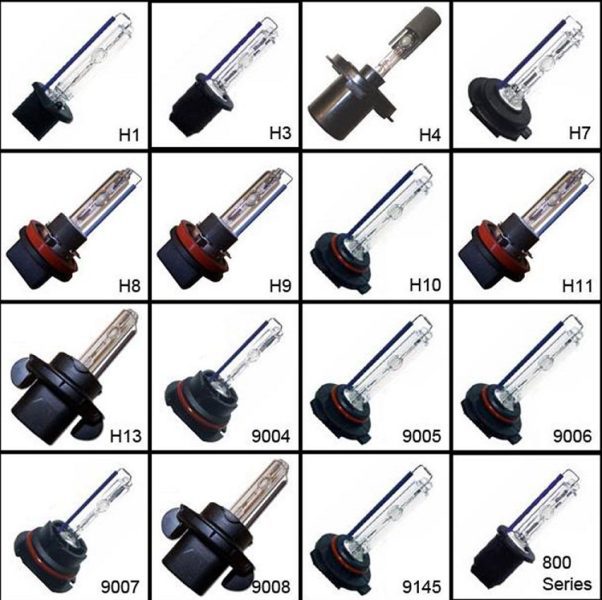
There are lamps with an integrated ignition unit in the base. In this case, the product marking will be D1S. Such lamps are easier to install in standard headlights. For headlights equipped with lenses, the marking is marked D2S (European cars) or D4S (Japanese cars).
The base with the designation H is used for dipped beam. Xenon marked H3 is installed in the foglights (there are also options for H1, H8 or H11). If there is an H4 inscription on the lamp base, then these are bi-xenon options. Their brightness varies between 4300-6000 K. Customers are offered several shades of glow: cold white, white and white with yellowness.
Among xenon lamps, there are options with an HB base. They are designed for fog lights and high beams. To determine exactly which type of lamp to purchase, you should refer to the vehicle manufacturer's manual.
The device of xenon headlights
Xenon headlights are made up of several components:
Discharge lamp
It is the xenon bulb itself, which contains xenon gas as well as other gases. When electricity reaches this part of the system, it produces a bright white light. It contains electrodes where electricity is “discharged”.
Xenon ballast
This device ignites the gas mixture inside the xenon lamp. Fourth generation Xenon HID systems can deliver up to 30 kV high voltage pulse. This component controls the starting of the xenon lamps, allowing the optimum operating phase to be reached quickly. Once the lamp is operating at optimum brightness, the ballast begins to control the power that is passed through the system to maintain brightness. The ballast contains a DC / DC converter that allows it to generate the voltage required to power the lamp and other electrical components in the system. It also contains a bridge circuit that supplies the system with 300 Hz AC voltage.
Ignition unit
As the name suggests, this component triggers the delivery of a "spark" to the xenon light module. It connects to xenon ballast and may contain metal shielding depending on the system generation model.
How xenon headlights work
Conventional halogen lamps pass electricity through a tungsten filament inside the lamp. Since the bulb also contains halogen gas, it interacts with the tungsten filament, thereby heating it and allowing it to glow.

Xenon headlights work differently. Xenon lamps do not contain a filament; instead, the xenon gas inside the bulb is ionized.
- Ignition
When you turn on the xenon headlight, electricity flows through the ballast to the bulb electrodes. This ignites and ionizes the xenon. - Heating
The ionization of the gas mixture leads to a rapid rise in temperature. - Bright light
The xenon ballast provides a constant lamp power of about 35 watts. This allows the lamp to operate at full capacity, providing a bright white light.
It is important to remember that xenon gas is used only in the initial lighting phase. As the other gases inside the bulb ionize, they replace the xenon and provide bright illumination. This means that it may take some time - often several seconds - before you can see the bright light generated by the xenon headlight.
Advantages of xenon lamps
The 35 watt xenon bulb can deliver up to 3000 lumens. A comparable halogen bulb can only gain 1400 lumens. The color temperature of the xenon system also simulates the temperature of natural daylight, which ranges from 4000 to 6000 Kelvin. On the other hand, halogen lamps give off a yellow-white light.
Wide coverage
Not only do hidden lamps produce brighter, more natural light; they also provide lighting further down the road. Xenon bulbs travel wider and farther than halogen bulbs, allowing you to drive much safer at night at high speeds.
Efficient energy consumption
It is true that xenon bulbs will require more power when starting up. However, in normal operation they consume much less energy than halogen systems. This makes them more energy efficient; although the advantage may be too small to be recognized.
Life time
An average halogen lamp can last 400 to 600 hours. Xenon bulbs can work up to 5000 hours. Unfortunately, xenon still lags behind the 25 hour LED life span.
high brightness
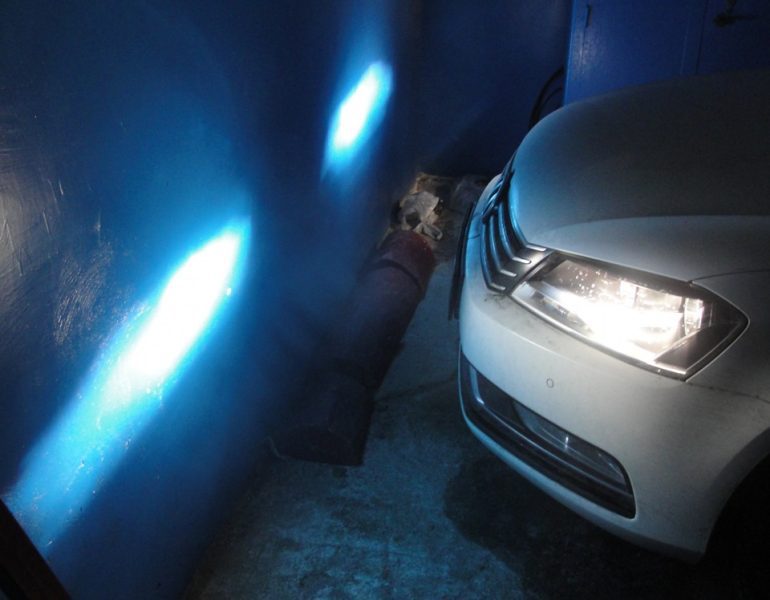
Xenon has the highest brightness among gas-discharge lamps. Thanks to this, such optics will provide maximum safety on the road due to better illumination of the roadway. Of course, for this you need to correctly select the bulbs if xenon is installed instead of halogens so that the light does not blind oncoming traffic.
Best color temperature
The peculiarity of xenon is that its glow is as close as possible to natural daylight. Thanks to this, the road surface is clearly visible at dusk, especially when it rains.
Brighter light in such conditions reduces driver eye strain and prevents rapid fatigue. Compared to classic halogens, xenon halogens can range from a yellowish hue that matches the light of the moon on a clear night to a cool white that is more like daylight on a clear day.
Less heat is generated
Since xenon lamps do not use a filament, the light source itself does not generate much heat during operation. Due to this, energy is not spent on heating the thread. In halogens, a significant part of the energy is spent on heat, and not on light, which is why they can be installed in headlights with glass rather than plastic.
Disadvantages of xenon lamps
Although xenon headlights provide exceptional natural daylight-like brightness, they do have some drawbacks.
Quite expensive
Xenon headlights are more expensive than halogen headlights. Although they are cheaper than LEDs, their average lifespan is such that you will need to replace your xenon bulb at least 5 times before you need to replace an LED.
High glare
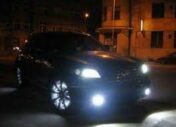
Poor quality or incorrectly tuned xenon can be hazardous to passing motorists. Glare can dazzle drivers and cause accidents.
Retrofitting from halogen headlights
If you already have halogen headlights installed, installing a xenon lighting system can be quite complicated and expensive. Of course, the best option is to have xenon in the drain.
It takes time to reach full brightness
Turning on the halogen headlight gives you full brightness in no time. For a xenon lamp, it will take a few seconds for the lamp to warm up and reach full operating power.
Xenon headlights are very popular these days due to the brightness they provide. Like everyone else, this car lighting system has its pros and cons. Weigh these factors to determine if you need xenon.
Leave your opinion and experience of using xenon in the comments - we'll discuss it!
How to choose xenon?
Considering that xenon requires competent installation, if there is no experience or exact knowledge in the installation of car optics, it is better to trust professionals. Some believe that to upgrade the head optics, it is enough to buy a lamp with a suitable base. In fact, xenon requires special reflectors that will correctly direct the light beam. Only in this case, even the dipped beam will not blind drivers of oncoming vehicles.
Specialists of a specialized car service will definitely recommend purchasing better and more expensive headlights, which in this case is justified. If the car is equipped with xenon headlights from the factory, then you can choose an analogue yourself. But even if you want to install bi-xenon, it is better to contact a specialized service station.
How to install xenon?
If you want to “pump” the car’s head light, you can buy LED lamps instead of standard halogens, but they are more effective as daytime running lights or interior lighting. The highest quality and powerful light is provided by laser optics. However, this technology will not soon be available to ordinary motorists.
As we have already found out, halogens are in many ways inferior in quality and reliability to xenon lamps. And even if the car from the assembly line was equipped with halogen optics, it can be replaced with a xenon counterpart.
But it is better not to upgrade the head optics yourself, because in the end a lot of time will be spent setting up unsuitable lamps, and you still have to turn to specialists.
Related videos
Here is a short video about which lamps shine better:


Watch this video on YouTube
Questions and answers:
What is xenon on a car? Xenon is the gas used to fill gas-discharge type automobile lamps. Their peculiarity is the brightness, which is twice as high as the quality of classical light.
Why is xenon banned? Xenon can be fitted if provided by the headlamp manufacturer. If the headlamp is intended for other lamps, then xenon cannot be used due to the difference in the formation of the light beam.
What happens if you put xenon? The light beam will not be formed correctly. For xenon, a special lens is used, an auto-corrector for the headlights, a different base, and the headlight must be equipped with a washer.

3 comment
Hisham Abdo
Can it be used in home lighting, and how is the device connected to a 12-volt battery?
Mohammed
Xenon lamp continuous spectrum or linear emission
Mohammed
Xenon lamp continuous spectrum or linear emission?